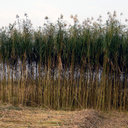The components of rice and watermelon root exudates and their effects on pathogenic fungus and watermelon defense.
Ключавыя словы
Рэферат
Watermelon (Citrullus lanatus) is susceptible to wilt disease caused by the fungus Fusarium oxysporum f. sp niveum (FON). Intercropping management of watermelon/aerobic rice (Oryza sativa) alleviates watermelon wilt disease, because some unidentified component(s) in rice root exudates suppress FON sporulation and spore germination. Here, we show that the phenolic acid p-coumaric acid is present in rice root exudates only, and it inhibits FON spore germination and sporulation. We found that exogenously applied p-coumaric acid up-regulated the expression of ClPR3 in roots, as well as increased chitinase activity in leaves. Furthermore, exogenously applied p-coumaric acid increased β-1,3-glucanase activity in watermelon roots. By contrast, we found that ferulic acid was secreted by watermelon roots, but not by rice roots, and that it stimulated spore germination and sporulation of FON. Exogenous application of ferulic acid down-regulated ClPR3 expression and inhibited chitinase activity in watermelon leaves. Salicylic acid was detected in both watermelon and rice root exudates, which stimulated FON spore germination at low concentrations and suppressed spore germination at high concentrations. Exogenously applied salicylic acid did not alter ClPR3 expression, but did increase chitinase and β-1,3-glucanase activities in watermelon leaves. Together, our results show that the root exudates of phenolic acids were different between rice and watermelon, which lead to their special ecological roles on pathogenic fungus and watermelon defense.



